From consumers to creators
As two of the Center’s original five fellows, McLean and Hoyle played a foundational role in creating what entrepreneurship looks like at W&M today. This experience was transformational for them both, taking them from “a consumer’s mindset to that of a creator,” according to Henshaw.
“Graham Henshaw gave us a tremendous amount of autonomy and ownership from an early stage,” McLean says.
This ownership came with significant responsibility to ideate, plan and execute the Center’s events and to track student demographics and engagement. As operations fellow, Hoyle wore many hats and was challenged to use his computer science background in new and innovative ways. He spearheaded building the Center’s website and developed different automations to raise student awareness and interaction as well as monitor attendance trends. This all involved a level of technical expertise, mathematics and troubleshooting that required tremendous creativity and focus.
“Working as a fellow was a great opportunity to apply the knowledge I was learning in the classroom in a practical way,” Hoyle says. “Graham really pushed us to develop sophisticated solutions to solve the Center’s problems.”
While Hoyle dove into the data, McLean got to work planning events to increase student engagement. One such event, which remains a core part of entrepreneurship at W&M, was the Rocket Pitch.
The Entrepreneurship Center began hosting pitch competitions every Friday, from 1-2 p.m. Participating students had 90 seconds to explain a problem of interest and their ideas for how to solve it. Winning pitches went on to compete at a larger end-of-semester competition with a panel of expert judges. Rocket Pitches were a fun, informal way for the fellows to drive student engagement with the Center, inspiring ideas and increasing participation.
However, McLean points to the coworking sessions after Rocket Pitches as the secret behind building the Center’s community.
“After Rocket Pitches, we had Cowork Fridays — time for students to socialize, share ideas and collaborate on projects. That is really where the community was created, during that unstructured, informal time.”
Thanks to culture-building activities such as these, more and more students started to show up for events at the Center. One of those students was Marcotullio, an inquisitive and somewhat skeptical junior.
As an 800-meter sprinter on the women’s track and field team and an art history enthusiast, Marcotullio shared similar interests with McLean and Hoyle. However, unlike the duo, she did not initially feel drawn toward entrepreneurship.
“To me, an entrepreneur equaled Mark Zuckerberg — a genius from birth who had wicked coding skills,” she says.
Lacking those wicked coding skills herself, Marcotullio didn’t see how this world could apply to her. However, moving into her junior year, she experienced some injuries which prevented her from continuing to run competitively. With a lot of time on her hands and a bit nervous about her post-graduation career opportunities, Marcotullio said yes when one of her friends invited her to a Rocket Pitch.
Rather than meeting a bunch of coding whiz kids (although there were some very strong coders, Hoyle included), Marcotullio was struck by the creativity and openness of the community.
“People were just throwing out these crazy ideas and trying to be as creative as possible,” she says. “There was a sense that anything was possible.”
This focus on innovation and thinking outside the box appealed to Marcotullio as a marketing major with a creative mindset. At her fifth Rocket Pitch, she decided to throw out her own idea — an app that would help people identify and sort recyclable material. She won that Friday’s competition and pitched again at the end-of-semester Entrepreneurship Week.
Although her environmentally savvy app ended there, a new chapter of Marcotullio’s university experience began. She had caught the entrepreneurship bug. Marcotullio eventually decided to become a fellow alongside McLean and Hoyle, using her marketing skills to spread the word about entrepreneurship at W&M.
A key part of her role was building relationships with W&M’s alumni entrepreneurs, inviting them to engage with students at the Center through on-campus talks and a sponsored internship program. As the “guinea pig” for the internship program, Marcotullio got her first internship at Map My Customers, an alumnus-founded startup. She would go on to work there after graduation.
In addition to Marcotullio’s work as a fellow, she also pursued her own entrepreneurial project, co-founding WM Laptops. A student-run venture, WM Laptops supplied students in a pinch with Chromebooks and made over $1,000 in revenue.
“It was an incredibly valuable experience,” says Marcotullio. “I learned about supply and demand, the customer experience and that I could try something completely new, figure it out and succeed.”
For Marcotullio, McLean and Hoyle, their time at the Entrepreneurship Center helped them get comfortable with the unknown, adapt to change and thrive in new and challenging situations. Not long after graduating from W&M, these newfound skills would be put to the test in both their personal and professional lives.
Facing adversity
At the start of the pandemic, McLean, Hoyle and Marcotullio were all working remotely. McLean had started a position as a solutions engineer at enterprise software company Oracle. Hoyle worked as an independent developer, helping early-stage startups build and grow their products. He also launched several startups of his own. And Marcotullio had gone on to work for Map My Customers, where she had interned during college.
Having stayed in close contact after graduation, they began to discuss the pandemic and how they might cope with it. During those conversations, which included other W&M friends, someone threw out the idea, “Why don’t we quarantine together at Airbnbs and travel the country?”
While many Americans may have had a similar thought, this set of friends went the actual distance and, in keeping with McLean’s tagline, made their idea more than an idea. Ending their leases and packing up their things, they headed off to their first location — South Carolina.
“What started as a couple-week hiatus turned into a several-year road trip,” says Hoyle.
As the pandemic wore on, the friends continued to live together, traveling to Colorado Springs, Seattle, San Diego and elsewhere. Mainly housing friends from W&M’s entrepreneurship community, these Airbnbs transformed into mini Entrepreneurship Centers, where the friends collaborated on projects and sought advice from one another.
“In many ways, those Airbnbs had a lot of the creativity and encouragement that was so palpably felt at the Center,” says McLean.
Faced with change and new challenges, this group of friends applied their shared entrepreneurial mindset to identify an opportunity and take action, helping them to cope and even thrive during the pandemic. These decisions paved the way for new avenues of opportunity, for it was at that first small Airbnb in South Carolina that the idea for Navattic took form.





